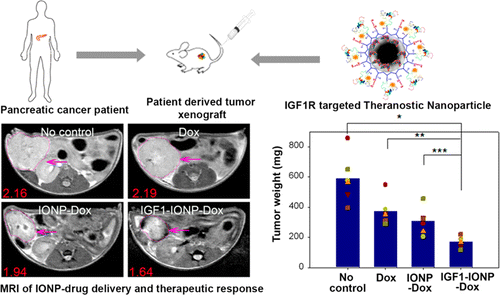Our official English website, www.x-mol.net, welcomes your
feedback! (Note: you will need to create a separate account there.)
IGF1 Receptor Targeted Theranostic Nanoparticles for Targeted and Image-Guided Therapy of Pancreatic Cancer
ACS Nano ( IF 15.8 ) Pub Date : 2015-08-10 00:00:00 , DOI: 10.1021/acsnano.5b01288
Hongyu Zhou , Weiping Qian , Fatih M. Uckun 1 , Liya Wang , Y. Andrew Wang 2 , Hongyu Chen 2 , David Kooby , Qian Yu , Malgorzata Lipowska , Charles A. Staley , Hui Mao , Lily Yang
ACS Nano ( IF 15.8 ) Pub Date : 2015-08-10 00:00:00 , DOI: 10.1021/acsnano.5b01288
Hongyu Zhou , Weiping Qian , Fatih M. Uckun 1 , Liya Wang , Y. Andrew Wang 2 , Hongyu Chen 2 , David Kooby , Qian Yu , Malgorzata Lipowska , Charles A. Staley , Hui Mao , Lily Yang
Affiliation

|
Overcoming resistance to chemotherapy is a major and unmet medical challenge in the treatment of pancreatic cancer. Poor drug delivery due to stromal barriers in the tumor microenvironment and aggressive tumor biology are additional impediments toward a more successful treatment of pancreatic cancer. In attempts to address these challenges, we developed IGF1 receptor (IGF1R)-directed, multifunctional theranostic nanoparticles for targeted delivery of therapeutic agents into IGF1R-expressing drug-resistant tumor cells and tumor-associated stromal cells. These nanoparticles were prepared by conjugating recombinant human IGF1 to magnetic iron oxide nanoparticles (IONPs) carrying the anthracycline doxorubicin (Dox) as the chemotherapeutic payload. Intravenously administered IGF1-IONPs exhibited excellent tumor targeting and penetration in an orthotopic patient-derived xenograft (PDX) model of pancreatic cancer featuring enriched tumor stroma and heterogeneous cancer cells. IGF1R-targeted therapy using the theranostic IGF1-IONP-Dox significantly inhibited the growth of pancreatic PDX tumors. The effects of the intratumoral nanoparticle delivery and therapeutic responses in the orthotopic pancreatic PDX tumors could be detected by magnetic resonance imaging (MRI) with IONP-induced contrasts. Histological analysis showed that IGF1R-targeted delivery of Dox significantly inhibited cell proliferation and induced apoptotic cell death of pancreatic cancer cells. Therefore, further development of IGF1R-targeted theranostic IONPs and MRI-guided cancer therapy as a precision nanomedicine may provide the basis for more effective treatment of pancreatic cancer.
中文翻译:

IGF1受体靶向的治疗性纳米颗粒用于胰腺癌的靶向和影像引导治疗
在胰腺癌的治疗中,克服对化学疗法的抗性是主要且未得到满足的医学挑战。由于肿瘤微环境中的基质屏障和侵袭性肿瘤生物学而导致的药物递送不良是胰腺癌更成功治疗的其他障碍。为了解决这些挑战,我们开发了IGF1受体(IGF1R)导向的多功能治疗治疗纳米颗粒,用于将治疗剂靶向递送至表达IGF1R的耐药性肿瘤细胞和与肿瘤相关的基质细胞中。通过将重组人IGF1与携带蒽环霉素阿霉素(Dox)作为化疗有效载荷的磁性氧化铁纳米颗粒(IONP)偶联来制备这些纳米颗粒。在胰腺癌的原位患者异种移植(PDX)模型中,静脉内施用的IGF1-IONPs表现出优异的肿瘤靶向性和穿透性,该模型具有丰富的肿瘤基质和异质性癌细胞。使用治疗性IGF1-IONP-Dox的IGF1R靶向疗法可显着抑制胰腺PDX肿瘤的生长。肿瘤内纳米颗粒递送和原位胰腺PDX肿瘤中治疗反应的影响可以通过磁共振成像(MRI)结合IONP诱发的对比来检测。组织学分析表明,以IGF1R为靶点的Dox递送显着抑制胰腺癌细胞的增殖并诱导其凋亡。所以,
更新日期:2015-08-10
中文翻译:

IGF1受体靶向的治疗性纳米颗粒用于胰腺癌的靶向和影像引导治疗
在胰腺癌的治疗中,克服对化学疗法的抗性是主要且未得到满足的医学挑战。由于肿瘤微环境中的基质屏障和侵袭性肿瘤生物学而导致的药物递送不良是胰腺癌更成功治疗的其他障碍。为了解决这些挑战,我们开发了IGF1受体(IGF1R)导向的多功能治疗治疗纳米颗粒,用于将治疗剂靶向递送至表达IGF1R的耐药性肿瘤细胞和与肿瘤相关的基质细胞中。通过将重组人IGF1与携带蒽环霉素阿霉素(Dox)作为化疗有效载荷的磁性氧化铁纳米颗粒(IONP)偶联来制备这些纳米颗粒。在胰腺癌的原位患者异种移植(PDX)模型中,静脉内施用的IGF1-IONPs表现出优异的肿瘤靶向性和穿透性,该模型具有丰富的肿瘤基质和异质性癌细胞。使用治疗性IGF1-IONP-Dox的IGF1R靶向疗法可显着抑制胰腺PDX肿瘤的生长。肿瘤内纳米颗粒递送和原位胰腺PDX肿瘤中治疗反应的影响可以通过磁共振成像(MRI)结合IONP诱发的对比来检测。组织学分析表明,以IGF1R为靶点的Dox递送显着抑制胰腺癌细胞的增殖并诱导其凋亡。所以,































 京公网安备 11010802027423号
京公网安备 11010802027423号